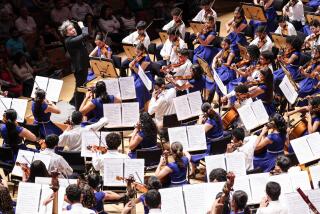Show for Children : Scoring High in Music Via Sports Link
How do you introduce children to the joy and beauty of classical music at a time when their near-universal refrain is “I want my MTV”?
At a few Los Angeles schools, it’s being done with a baseball bat, a tennis racket and two adventuresome musicians with the Los Angeles Philharmonic.
That’s violinist Paul Stein’s idea of how you get kids to listen to chamber music these days. In his “What’s the Score--Music as Art and Sport” programs, the musician demonstrates how the same principles that create outstanding sports performances--rhythm, relaxation and imagination--also contribute to the best musical performances, not to mention the most enjoyable lives.
An Elementary Show
Last Friday afternoon, for instance, Stein and accompanist Gloria Cheng presented one of their sports-and-music shows for an auditorium full of students at Glassell Park Elementary School.
To get the attention of these kindergarten through third-graders, Stein quickly asked how many of them had played baseball (everybody). Then, how many had ever played the piano or the violin (only a few).
As Stein believes that people are frequently more intimidated by the small movements involved in playing an instrument than they are by the large movements in playing a sport, he demonstrated a variety of ways in which the two fields are essentially the same.
“You know how all those baseball players get great? By watching other baseball players,” he told the children. “It’s always important when you watch baseball players that you imagine that it’s you that’s playing. That helps to give you what’s called confidence. It’s the same thing in music.”
So they could watch him play (and start imagining that it was possible for them to do it too), Stein launched into Paul Nero’s pop classic, “The Hot Canary” (“about the loudest, ‘funnest’ canary”). Without being told to, many in the audience were not only imagining themselves playing along with him, they were actually plucking and bowing their make-believe violins.
Then Stein decided to hit them with a piece by Charles Ives, the American composer whose penchant for dissonance has been known to send even adults back to the Top 40.
“This is not a piece you might hear at Disneyland. It’s not, ‘It’s a Small World.’ It’s supposed to sound pretty crazy,” Stein warned his listeners, introducing an Ives’ sonata titled “Children’s Day at the Camp Meeting.”
Having been primed that the piece was basically about a fight between an old man (represented by the piano) and some young boys who went from being nice to being crazy (represented by the violin), this audience had no trouble with Ives. In fact, they seemed to love it.
The children likewise had no trouble comprehending the notion of rhythm in a Ravel sonata after Stein showed them what differences in their own rhythms might look like: going-to-the-dentist rhythms versus racing-to-class-because-you’re-late rhythms.
To demonstrate the importance of relaxation, Stein showed them how the violin sounded when his fingers were tight and when they were loose on Leroy Anderson’s “Plink, Plank, Plunk.” And he pointed out that playing the music was not unlike dancing around in a game of hopscotch. About halfway through the 40-minute show, Stein pulled out some of his props: a baseball bat and a huge, oversize tennis racket.
“Have you ever seen somebody who tries to hit a ball, but they don’t swing the bat back first,” he said, demonstrating a limited swing. “If they’re lucky enough to hit the ball, it doesn’t go very far. In music, there’s the same thing . . . (swinging the bat back) called a pick-up.”
A Point With Tennis Racket
Then he picked up a giant tennis racket nearly half his size, held it near his face and explained that he really understood how little kids must feel when they hold a violin.
It wasn’t real clear what any of this had to do with the excerpts Stein and Cheng played from Scott Joplin’s “Pleasant Memories” or Beethoven’s “Sonata in C Minor,” but it didn’t seem to matter. Stein captured the attention of his audience--along with considerable applause, a few shouts of “Bravo!” and a standing ovation orchestrated by Glassell Park principal Richard Warnick.
After the program, Stein took a few moments to explain that the principles of rhythm, relaxation and imagination are the same ideas that have helped him to improve his own performance as an adult--both in music and sports.
A second violinist with the Philharmonic for the last three years, Stein said that when he was a violinist with the Denver symphony, he took up tennis and noticed his music substantially improved as well. He read Tim Gallwey’s “Inner Game of Tennis,” (which, according to Cheng, is now considered a “bible” by many musicians).
Getting Out of His Own Way
“I became aware that the less hard I tried and the more relaxed I became, the better I was able to think and do,” Stein noted, adding that much of what he learned to do in tennis and music was get out of his own way and let his natural abilities come forth.
In his sports-and-music presentations, which are funded by the Musicians Union’s Music Performance Trust Fund, Stein takes a similar approach with children.
“I just want them to focus on three things: rhythm, relaxation and imagination. If you had to boil down the most essential things about music, it would be those three things,” he said. “The kids already love music. I don’t want to mess that up.”
More to Read
The biggest entertainment stories
Get our big stories about Hollywood, film, television, music, arts, culture and more right in your inbox as soon as they publish.
You may occasionally receive promotional content from the Los Angeles Times.










